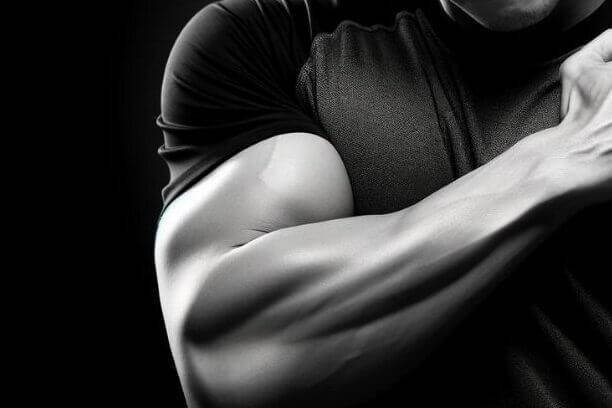Let’s be honest, most of us care about the shape of our backside, even if we don’t admit it.
While we may focus on developing a six-pack or toned biceps, many people start exercising to improve the strength and appearance of their glutes.
Whether your goal is to achieve a beach-ready body or feel more confident in your favorite skinny jeans, this simple guide will help you through a simple and effective workout routine to help you reach your goals.
Understanding Glute Anatomy and Function
The glutes are a group of three muscles – the gluteus maximus, gluteus medius, and gluteus minimus – that make up your buttocks. These muscles play a crucial role in hip extension, which is necessary for movements like walking, running, and jumping.
In addition to hip extension, the glutes also play a role in hip abduction (moving the leg away from the midline of the body) and hip external rotation (rotating the leg outward). Strong glutes can help improve posture, reduce the risk of injury, and enhance athletic performance.
To effectively target the glutes, it’s important to understand how they function in relation to other muscles in the body.
The hip flexors, for example, are a group of muscles that run from the pelvis to the thigh bone and are responsible for hip flexion (bringing the leg toward the body). Tight hip flexors can inhibit glute activation, making it more difficult to target the glutes during exercise.
Body composition also plays a role in glute development. While exercise can help strengthen and tone the glutes, it’s important to maintain a healthy diet and body fat percentage to see optimal results.
Essential Glute-Shaping Exercises
When it comes to sculpting a better bottom, there are a few essential exercises that should be a part of your glute workout routine. These exercises target the muscles in your lower body, particularly your glutes, hips, and hamstrings, and can help you build strength, power, and definition in your backside.
Barbell Squat
The barbell squat is a classic lower body exercise that is great for building strength and power in your glutes, quads, and hamstrings.
To perform a barbell squat, stand with your feet shoulder-width apart and hold a barbell across your upper back. Bend your knees and lower your body until your thighs are parallel to the ground, then push back up to the starting position. Make sure to keep your knees in line with your toes and your back straight throughout the movement.
Hip Thrusts
Hip thrusts are another great exercise for targeting your glutes and building strength in your lower body.
To perform a hip thrust, sit on the ground with your back against a bench or pad, and place a barbell across your hips. Lift your hips up towards the ceiling, squeezing your glutes at the top of the movement, then lower back down to the starting position. Make sure to keep your core engaged and your pelvis in a neutral position throughout the movement.
Deadlift Variations
Deadlifts are a compound exercise that target your glutes, hamstrings, and lower back, and can be performed in a variety of ways to target different muscles in your lower body.
Conventional deadlifts, sumo deadlifts, Romanian deadlifts, and stiff-legged deadlifts are all great variations to include in your glute workout routine. Make sure to use heavy weights and proper form to avoid injury and maximize the benefits of the exercise.

Lunges and Split Squats
Lunges and split squats are unilateral exercises that help to improve balance and stability, while also targeting your glutes, quads, and hamstrings.
Weighted lunges and Bulgarian split squats are particularly effective for building strength and definition in your lower body. Make sure to keep your knees in line with your toes and your back straight throughout the movement.
Step-Ups and Glute Bridges
Step-ups and glute bridges are two more exercises that are great for targeting your glutes and building strength in your lower body.
To perform a step-up, stand in front of a bench or box and step up onto it with one foot, then step back down to the starting position. Glute bridges involve lying on your back with your knees bent and your feet flat on the ground, then lifting your hips up towards the ceiling and squeezing your glutes at the top of the movement.
Advanced Glute Training Strategies
If you’re looking to take your glute training to the next level, there are a few advanced strategies you can use to maximise your results.
By incorporating variations and accessories, targeting upper and lower glutes, utilising compound movements, and exploring unilateral exercises, you can challenge your muscles in new ways and achieve a better bottom.
Incorporating Variations and Accessories
One way to take your glute training up a notch is to incorporate variations and accessories into your workouts.
For example, you could try using resistance bands to add extra resistance to your exercises, or use ankle weights to increase the difficulty of your leg lifts.
Another option is to incorporate different variations of your favourite exercises. For example, you could try a sumo squat instead of a regular squat to target your inner thighs and glutes, or a single-leg deadlift to challenge your balance and stability.
Targeting Upper and Lower Glutes
To achieve a well-rounded glute workout, it’s important to target both your upper and lower glutes.
While many exercises, such as squats and lunges, work both areas, there are some exercises that specifically target one or the other.
To target your upper glutes, try exercises such as hip thrusts, glute bridges, and cable kickbacks. To target your lower glutes, try exercises such as step-ups, reverse lunges, and Bulgarian split squats.
Utilising Compound Movements
Compound movements are exercises that work multiple muscle groups at once, making them an efficient and effective way to train your glutes.
Some examples of compound movements that are great for glute training include barbell squats, deadlifts, and kettlebell swings.
By incorporating compound movements into your glute workouts, you can work multiple muscle groups at once, which can help you build strength and power more quickly.
Exploring Unilateral Exercises
Unilateral exercises are exercises that work one leg at a time, which can help you improve your balance and stability, as well as target any muscle imbalances you may have.
Some examples of unilateral exercises that are great for glute training include lunges, step-ups, and single-leg deadlifts.
Nutrition and Recovery for Glute Growth
If you’re looking to build a better backside, you need to pay attention to your nutrition and recovery. Here are some key considerations to help you maximize your glute gains.

Dietary Considerations for Muscle Gain
To build muscle, you need to consume enough calories and protein to support growth.
Aim for a calorie surplus of 250-500 calories per day and a protein intake of 1.6-2.2g/kg body weight per day. Make sure you’re also getting enough carbohydrates and healthy fats to fuel your workouts and support recovery.
Focus on nutrient-dense, whole foods like lean meats, fish, eggs, dairy, whole grains, fruits, and vegetables. Avoid processed foods and excess sugar, which can lead to inflammation and hinder progress.
Importance of Rest and Recovery
Muscle growth occurs during periods of rest and recovery, not just during workouts.
Make sure you’re getting enough sleep (7-9 hours per night) and taking rest days as needed to allow your muscles to repair and grow.
In addition to sleep and rest, consider incorporating active recovery strategies like foam rolling, stretching, and low-intensity cardio to help improve blood flow and reduce muscle soreness.
Supplementation for Performance Enhancement
While a balanced diet should provide most of the nutrients you need for muscle growth, some supplements may help enhance performance and recovery.
Creatine monohydrate, for example, has been shown to increase strength and muscle mass. Beta-alanine may also help improve endurance and delay fatigue.
Keep in mind that supplements are not a magic bullet and should be used in conjunction with a healthy diet and exercise program.
Home Workout Alternatives for Glute Building
If you’re unable to go to the gym, or you prefer to work out in the comfort of your own home, there are plenty of exercises you can do to build your glutes. Here are some home workout alternatives for glute building.

Bodyweight Exercises for Glutes
Bodyweight exercises are a great way to build your glutes without any equipment.
Some of the best bodyweight exercises for glutes include:
- Glute bridge: Lie on your back with your knees bent and feet flat on the floor. Lift your hips up towards the ceiling, squeezing your glutes at the top. Lower your hips back down and repeat.
- Squat: Stand with your feet shoulder-width apart and toes pointing slightly outwards. Bend your knees and lower your hips down towards the floor, keeping your chest up and back straight. Push through your heels to stand back up and repeat.
- Lunge: Stand with your feet hip-width apart. Step forward with your left foot and bend both knees to lower your body towards the floor. Push through your left heel to stand back up and repeat on the other side.
Improvised Equipment and Resistance Training
If you don’t have any weights or equipment at home, you can use everyday items to add resistance to your workouts.
Some examples include:
- Water bottles: Fill up some water bottles and use them as dumbbells.
- Backpack: Fill up a backpack with heavy items and wear it while doing squats or lunges.
- Resistance bands: These can be purchased online and are great for adding resistance to bodyweight exercises.
Creating a Home Workout Space
Creating a dedicated workout space in your home can help you stay consistent with your workouts. Here are some tips for creating a home workout space:
- Find a quiet and clutter-free area in your home.
- Invest in a yoga mat or exercise mat to make your workouts more comfortable.
- Use a small table or bench as a makeshift weight bench.
Consistency is key when building your glutes. Try to incorporate these exercises into your routine at least a few times a week for best results.







